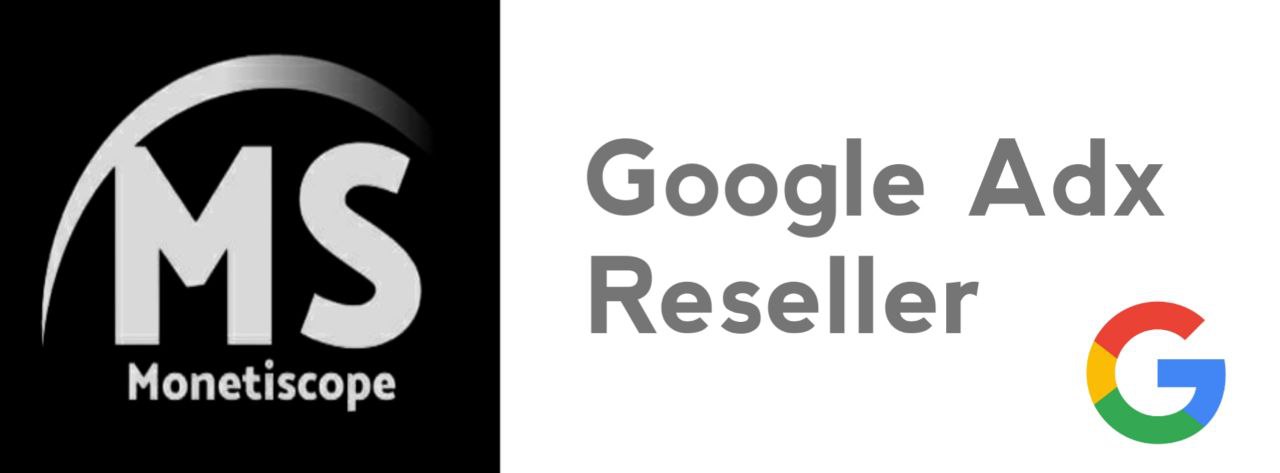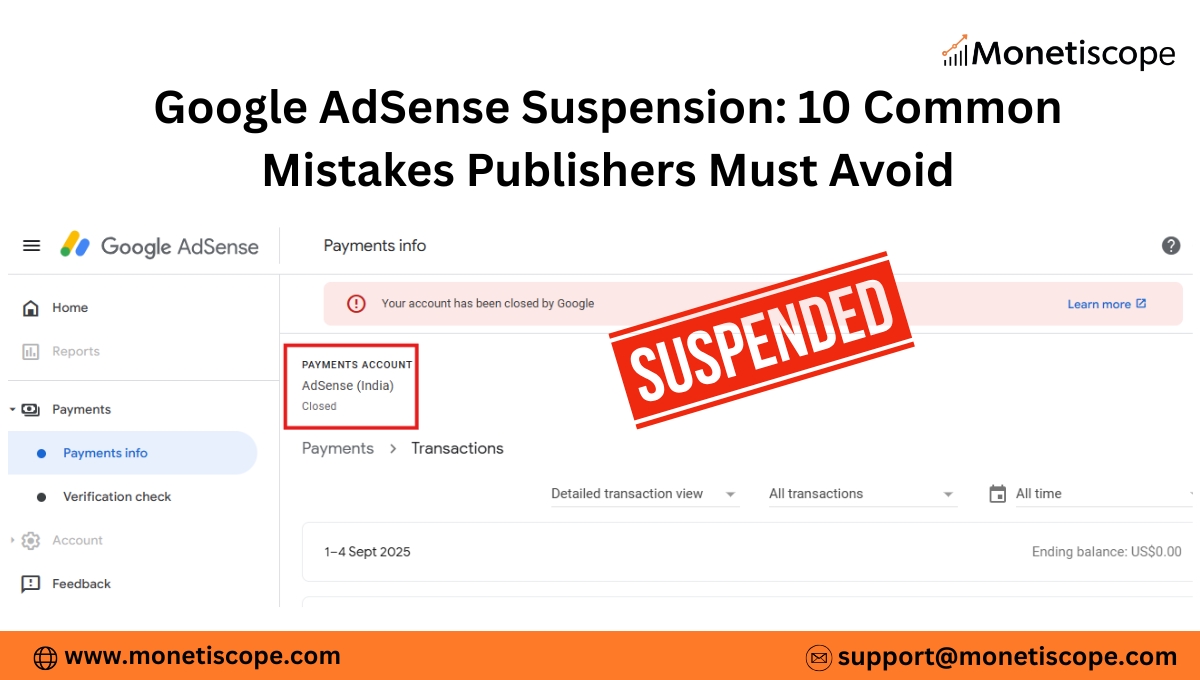Google AdSense has always been one of the most popular ways for publishers to monetize websites. It’s easy to integrate, provides access to high-quality ads, and offers publishers a steady income stream. However, many website owners face one big problem: AdSense account suspension.
When Google suspends your AdSense account, your revenue stops immediately. For many publishers, this can feel like the end of the road. The truth is, most suspensions happen due to avoidable mistakes. Google has strict policies, and even small violations can trigger a suspension.
But here’s the good news—if you know the rules and follow them, you can avoid most risks. In this article, we’ll break down the 10 most common mistakes publishers make that lead to Google AdSense suspension. More importantly, we’ll explain how to avoid each one with clear, practical steps.
Top 10 Mistakes That Get Your Google AdSense Account Suspended (And How to Avoid Them)
1. Clicking on Your Own Ads
One of the fastest ways to lose your AdSense account is by clicking your own ads. Google treats this as invalid activity because it artificially inflates revenue. Many beginners think clicking a few ads won’t matter. But Google’s system is smart enough to detect self-clicks, repeated patterns, and even accidental clicks.
For example, if you click an ad to “test it” or ask a friend to click, you’re already breaking the rules. Google’s algorithms analyze IP addresses, user behavior, and unusual traffic spikes. Once they notice a pattern, they suspend your account.
How to Avoid This Mistake:
- Never click your own ads under any circumstance.
- Use Google’s “Ad Review Center” to see the ads being shown instead of testing them live.
- If you want to check if ads are displaying correctly, use Google Publisher Toolbar (or simply view your site without interacting with ads).
Remember: even accidental clicks from you or people close to you can be flagged as suspicious activity.
2. Generating Fake Traffic
Buying traffic from shady providers or using bots is another major mistake. Many publishers think, “More traffic equals more clicks.” But if the traffic isn’t organic or high quality, Google considers it invalid traffic.
Bots, paid traffic farms, or incentivized clicks damage your account reputation. Not only does this lead to suspension, but advertisers also lose trust in your site. Google’s machine learning system tracks traffic sources, bounce rates, and user engagement to detect fake patterns.
How to Avoid This Mistake:
- Focus on organic SEO and social media marketing for genuine visitors.
- Avoid “get 10,000 visits for $5” type of services.
- Monitor traffic sources in Google Analytics. If you see suspicious spikes, investigate immediately.
- Partner only with reputable ad networks or traffic sources.
It’s better to have 500 genuine visitors than 5,000 fake ones that put your AdSense at risk.
3. Placing Ads on Prohibited Content
Google has strict rules about where you can place ads. If your website contains content related to adult material, gambling, drugs, copyrighted material, or violence, your AdSense account is at risk.
Some publishers unknowingly post copyrighted images, pirated software links, or videos without permission. Others create “gray-area” content like fake news or clickbait. Even if this content attracts high traffic, Google won’t allow ads to run on it.
How to Avoid This Mistake:
- Read and understand Google’s content policies carefully.
- Regularly audit your website for prohibited or sensitive material.
- Use only original or licensed content (images, videos, and text).
- Avoid creating misleading or harmful content just to get traffic.
Always remember, content quality and compliance matter more than short-term traffic growth.
4. Misleading Ad Placement
Some publishers try to trick users into clicking ads by placing them in misleading positions. Examples include:
- Placing ads too close to navigation buttons.
- Making ads look like part of the website menu.
- Using colors or layouts that confuse ads with content.
This practice leads to accidental clicks, which Google views as policy violations. It’s tempting to increase revenue with tricky placement, but Google’s system is quick to detect such practices.
How to Avoid This Mistake:
- Keep ads clearly distinguishable from content.
- Follow Google’s ad placement guidelines (no ads too close to clickable areas).
- Use clear labels like “Advertisement” or “Sponsored” when needed.
- Focus on user experience rather than aggressive ad placement.
When users trust your site, they click naturally. Forced clicks only harm your reputation and revenue in the long run.
5. Excessive Ads and Poor User Experience
Nobody likes a website where ads are everywhere. If your site bombards visitors with too many ads, Google will flag it for poor user experience. Pages overloaded with pop-ups, sticky banners, or auto-playing video ads push users away.
Remember, Google values websites that prioritize content. If ads distract users from consuming your content, your account is at risk.
How to Avoid This Mistake:
- Follow the Better Ads Standards for placement and number of ads.
- Maintain a good balance between ads and content.
- Avoid auto-playing audio or video ads unless user-triggered.
- Focus on fast-loading, mobile-friendly pages.
Always ask yourself: Would I enjoy browsing this website? If the answer is no, fix your ad strategy.
6. Not Owning Original Content
AdSense strongly supports publishers who create unique and valuable content. If your site is filled with copied or scraped material, you risk suspension. Google’s algorithm rewards originality, so duplicate or low-quality content is a red flag.
Some publishers use AI tools to generate entire blogs without edits. While AI can help, publishing unedited, repetitive, or meaningless content violates Google’s content quality guidelines.
How to Avoid This Mistake:
- Create high-quality, original articles, videos, or infographics.
- Use plagiarism checkers before publishing.
- If using AI tools, always edit and add your personal input.
- Focus on content that solves problems or educates readers.
Original content not only protects your AdSense account but also helps you rank better on Google Search.
7. Ignoring Mobile-Friendly Experience
Most users today browse websites on mobile. If your website isn’t mobile-friendly, you risk both low earnings and possible policy violations. A poor mobile layout can cause accidental clicks, slow load times, or distorted ads.
Google emphasizes mobile-first indexing, meaning your site’s mobile performance directly affects its ranking and ad approval.
How to Avoid This Mistake:
- Use a responsive website design.
- Test your site with Google’s Mobile-Friendly Test tool.
- Optimize images and code for faster loading.
- Avoid placing ads where users might click accidentally on mobile screens.
Smooth mobile experience increases trust and ensures better ad engagement.
8. Ignoring Policy Updates
Google updates its AdSense policies regularly. Many publishers ignore these changes and unknowingly violate new rules. What was acceptable last year may no longer be allowed today.
For instance, ad placement rules, content guidelines, and traffic sources keep evolving. If you don’t stay updated, you may face suspension.
How to Avoid This Mistake:
- Subscribe to Google AdSense official blog or policy updates.
- Check your AdSense dashboard for policy violation warnings.
- Join AdSense publisher forums to stay informed.
- Audit your site every few months to ensure compliance.
Awareness is the best way to prevent unintentional mistakes.
9. Using Multiple AdSense Accounts
Google’s policy is strict: one publisher, one AdSense account. Some publishers try to bypass suspensions by creating multiple accounts with different emails or names. This almost always backfires.
Google links accounts using payment details, IP addresses, and other signals. If they catch you running multiple accounts, they can permanently ban you.
How to Avoid This Mistake:
- Stick to one AdSense account.
- If your account is suspended, appeal the decision instead of opening a new one.
- Use family or business accounts only if they are separate legal entities.
Trust is key. Once you lose Google’s trust, recovery becomes very difficult.
10. Ignoring AdSense Warnings
Before suspension, Google often sends policy violation warnings. Many publishers ignore these warnings, thinking they’re minor issues. This is a huge mistake. If you don’t fix violations in time, your account can be suspended permanently.
How to Avoid This Mistake:
- Regularly check your AdSense dashboard for alerts.
- Take action immediately when you see a warning.
- If unsure, reach out to Google support or consult publisher communities.
- Keep a record of all changes made to fix violations.
Think of warnings as a second chance. Ignoring them means losing that chance forever.
Final Thoughts
Google AdSense is one of the best ways to monetize your website. But it comes with strict rules to protect advertisers and users. Most suspensions happen not because publishers cheat, but because they don’t know the rules or ignore them.
By avoiding these 10 mistakes, you can protect your account and build a stable income stream. Remember: focus on genuine traffic, quality content, and user experience. When your visitors are happy, your AdSense earnings will naturally grow.
FAQs about Google AdSense Suspension
How long does a Google AdSense suspension last?
Suspensions can last from 30 days to permanent bans, depending on the severity of the violation.
Can I get my suspended AdSense account back?
Yes, if it’s a temporary suspension, you’ll regain access after fixing violations. For permanent bans, appeals are limited.
Can I open a new AdSense account after suspension?
No. Google does not allow multiple accounts. If you’re permanently banned, creating a new account can lead to another ban.
Does AdSense ban affect my YouTube channel?
Yes, if the same account is linked. Policy violations on websites can sometimes affect YouTube monetization.
How do I know why my AdSense was suspended?
Google usually sends an email with reasons. You can also check your AdSense dashboard for policy violation notices.
Can accidental clicks really cause suspension?
Yes. Even repeated accidental clicks may look suspicious. Always test ads with tools, not live clicks.
Is it safe to use AI-generated content with AdSense?
Yes, if the content is original, helpful, and edited. Low-quality or spammy AI content violates Google’s policies.
What’s the best way to stay updated with AdSense rules?
Subscribe to Google AdSense updates, follow the official blog, and check your dashboard regularly for policy alerts.


